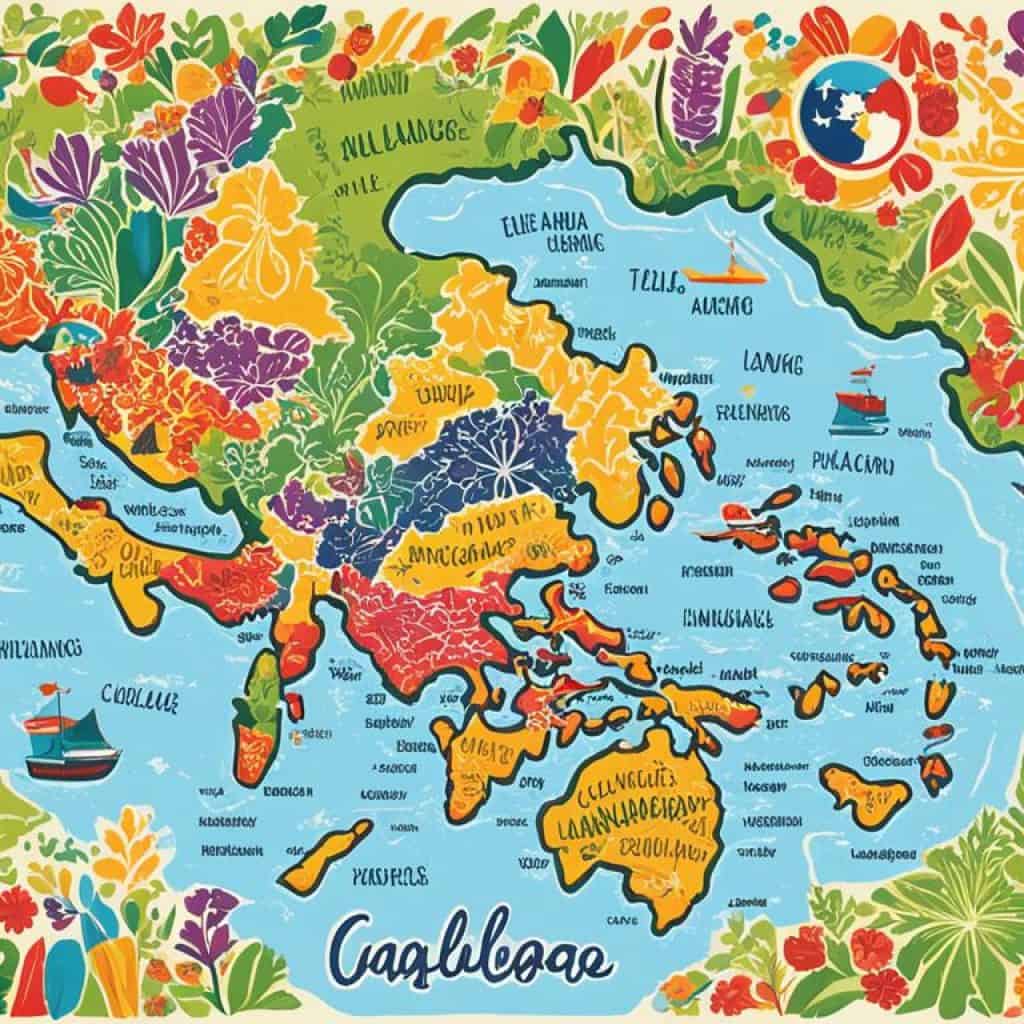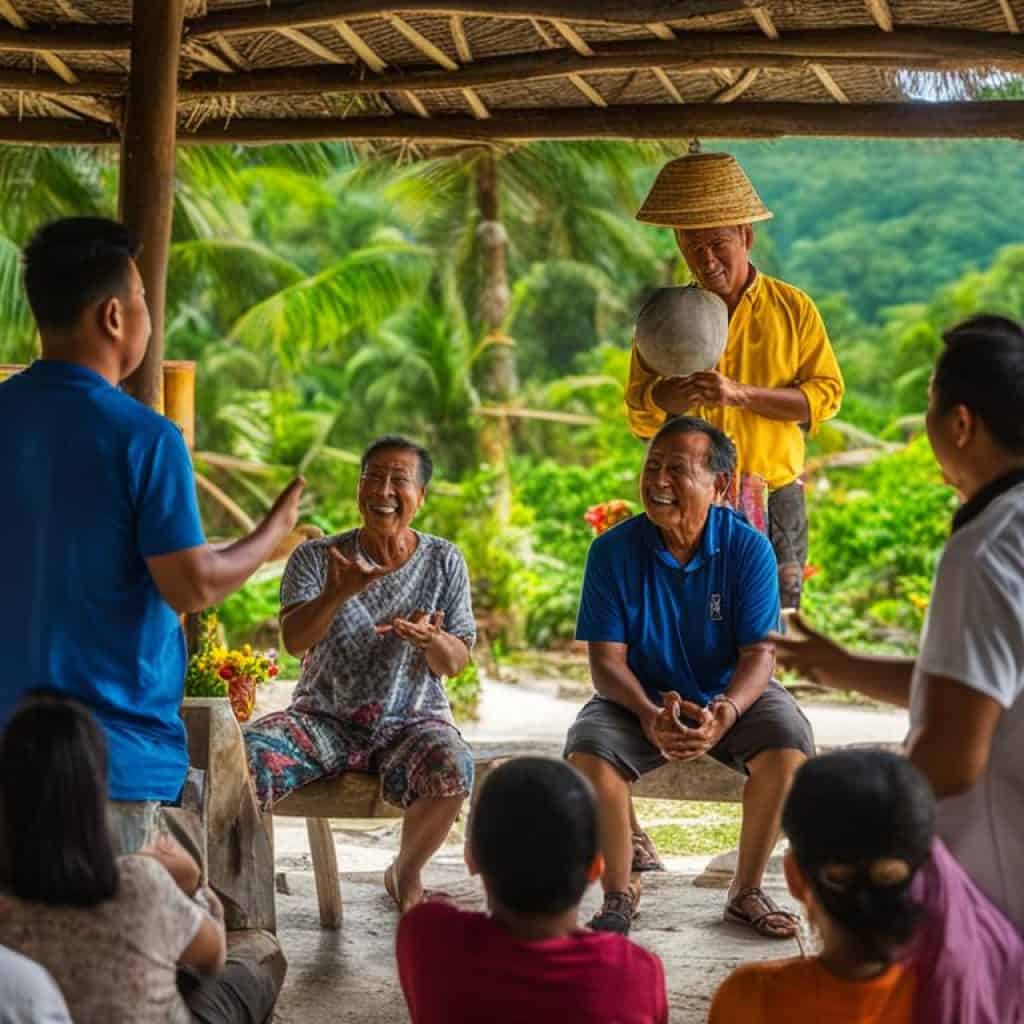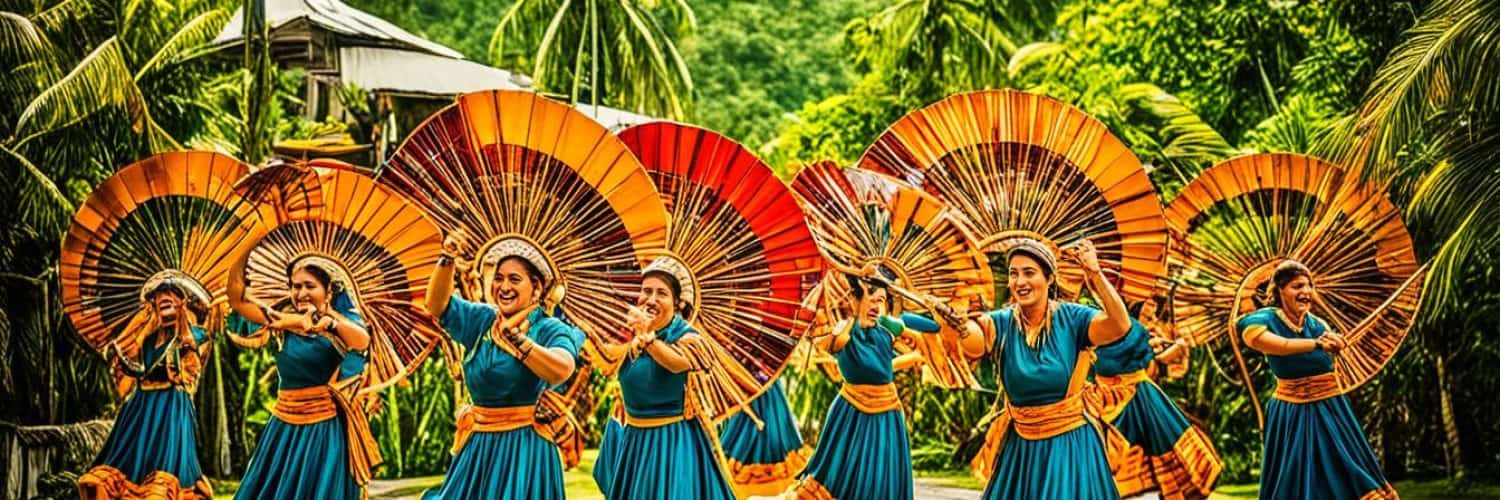Have you thought about the special language of Bohol, Philippines? Learn about Bohol Tagalog. It’s a version of the Filipino language that’s full of culture. It makes your trip better. You’ll learn simple ways to say hello, order food, and get around. Dive into Bohol’s rich culture and language. Start your language adventure now and get closer to Filipino traditions.
Key Takeaways
- Bohol Tagalog is a unique dialect spoken in Bohol, Philippines, and is a variation of the Filipino language.
- Learning Bohol Tagalog allows you to interact seamlessly with the local community and enhances your travel experience.
- Basic greetings, dining phrases, transportation phrases, and essential tourist phrases are essential to engage with the locals and navigate the beautiful province of Bohol.
- Understanding Bohol Tagalog deepens your understanding of the Filipino culture and fosters cultural sensitivity.
- Embracing Bohol Tagalog opens doors to a vibrant and authentic Filipino cultural experience.
The Significance of Bohol Tagalog in Filipino Culture
Bohol Tagalog is very important in Filipino culture and language. It’s one of the major languages, spoken by about 29 million people natively. In Bohol, Tagalog shows the area’s culture and heritage with its special features.
Learning Bohol Tagalog helps you communicate better with locals. It also makes you appreciate Filipino culture more. By understanding this dialect, you’ll see the rich cultural diversity in the Philippines.
When you explore Bohol’s language culture, you connect with Tagalog speakers. This immersion helps you to have deeper conversations. It also helps you understand the culture better, making your time in Bohol richer.
“Language is the road map of a culture. It tells you where its people come from and where they are going.” – Rita Mae Brown
By learning Bohol Tagalog, you make your trip to the Philippines more meaningful.
Basic Greetings and Personal Introductions in Bohol Tagalog
Get to know basic greetings and personal introductions in Bohol Tagalog. This will help you connect with locals in a friendly way. Knowing these phrases makes a great first impression and creates a strong bond with the Bohol Tagalog-speaking community.
Start with these essential phrases:
- “Maayong buntag!” – Good morning!
- “Kumusta?” – Hello, how are you?
- “Nag puyo ko sa [place]/Taga-[place] ko” – I live in [place].
These greetings and introductions let you speak confidently with Tagalog speakers in Bohol. They ensure you are warmly welcomed by locals.
Learning these basic phrases shows you respect the Bohol Tagalog dialect. It also shows you value the culture of the local community.
Engaging with the Local Community
Diving into the local culture of Bohol is amazing. Knowing Bohol Tagalog helps you have real conversations with locals. It’s important for travel, business, or study. Knowing how to greet and introduce yourself is very useful.
“Learning a few words in the local language can go a long way in showing respect and building rapport with the locals.” – Traveler’s Digest
Greet someone with “Maayong buntag!” or start a chat with “Kumusta?”. Even sharing where you live can make a big difference. The local community will love your effort to learn their phrases.
Creating Cultural Connections
Learning Bohol Tagalog opens up new cultural understandings. It helps you bond with locals and learn about their traditions. Language is key to truly appreciating the Philippines’ diversity.
Imagine the happy reactions when you introduce yourself in Bohol Tagalog. Or when you exchange friendly words with someone. Your efforts to overcome language barriers are appreciated. Locals are keen to share more about their culture with you.
So, explore Bohol Tagalog greetings and introductions. Begin a journey of cultural exploration that takes you deeper than just travel.
| Greetings/Introductions | English Translation |
|---|---|
| “Maayong buntag!” | Good morning! |
| “Kumusta?” | Hello, how are you? |
| “Nag puyo ko sa [place]/Taga-[place] ko” | I live in [place]. |
Dining in Bohol – Useful Phrases in Bohol Tagalog
Exploring Bohol’s exciting food scene? It’s good to know some local phrases. These phrases help you talk with locals and show respect for their culture and language.
Here are some key phrases for better dining experiences:
- “Mangaon ta!” – Say “Let’s eat!” to start your meal. This phrase shows you’re ready to try local foods. It also helps you bond with your meal buddies.
- “Lami!” – Enjoying your meal? Say “Delicious!” It shares your enjoyment with locals and chefs. It’s a kind word that brings joy to those who cooked your meal.
- “Ang bayronon palihug/Ang bill palihug” – Ready to pay? Use “The bill, please.” It’s a polite way to ask for your bill. It shows you know the local ways, making a good impression.
Using these phrases makes your Bohol dining more fun. You’ll feel closer to the local community. Plus, you’ll enjoy Bohol’s amazing food while learning about the culture.
Getting Around Bohol – Transportation Phrases in Bohol Tagalog
Learn transportation phrases in Bohol Tagalog to navigate Bohol with ease. These phrases are perfect for exploring stunning beaches or historic attractions. They’ll help you communicate effectively and enjoy your island time fully.
Key Transportation Phrases:
“Mogikan ko sa [place]” – I’m coming from [place]
“Muadto ko sa [place]” – I’m going to [place]
“Asa ko manaog?” – Where do I get off?
“Tagpila ang plete?” – How much is the fare?
Planning your day trip in Bohol? Use these phrases to share your start and end points. Say “Mogikan ko sa Panglao” if you’re leaving from Panglao Island. This lets drivers or locals know your departure point.
Going to the Chocolate Hills? Just say “Muadto ko sa Chocolate Hills.” This tells others your destination.
Knowing where to get off on public transport is key. Ask “Asa ko manaog?” to learn your stop when on buses or jeepneys.
Also, learn “Tagpila ang plete?” to ask about fares. This helps plan your spending and prevents surprises.
Public Transportation Tips:
- Keep small bills handy for exact fares on public transport.
- Always ask locals for direction and bus stops, as signs might be unclear.
- Expect some delays or schedule changes, especially in tourist season.
Mastering these phrases means a smoother journey through Bohol’s beautiful spots. Enjoy your trip without stress.
Exploring Bohol – Essential Phrases for Tourists
When you visit Bohol, knowing a few key Bohol Tagalog phrases can be very helpful. It makes talking to locals and getting information easier. Here are some must-know phrases for touring the island and enjoying its sights:
- “Kita lang ta unya” – See you later.
- “Unsa ni?” – What is this?
- “Asa ang [place]?” – Where is the [place]?
- “Mo-agi ba ni sa [place]?” – Is this going to pass through [place]?
These expressions are useful when you’re talking to locals, looking for places, or asking for tips. Learning Bohol Tagalog lets you have a deeper and more fun visit to Bohol.
Testimonials from Travelers:
“Learning a bit of Bohol Tagalog made my Bohol trip far better. The locals liked that I tried speaking their language. It helped me connect more with their culture. I suggest learning some phrases before you go!”
– Maria, Traveler
“For someone who likes seeing places less traveled, knowing Bohol Tagalog was key in Bohol. It let me talk with locals, move around the island easily, and find special spots only locals know.”
– Mark, Adventurer
Useful Phrases for Getting Around:
Dining:
| Phrase | Translation |
|---|---|
| “Mangaon ta!” | Let’s eat! |
| “Lami!” | Delicious! |
| “Ang bayronon palihug/Ang bill palihug” | The bill, please. |
-// The continuation is NOT included in this document //-
The Importance of Tagalog in the Philippines
Tagalog is the foundation of the Philippines’ official language, Filipino. It’s widely used and crucial for business and tourism. Mastering Tagalog shows your cultural adaptability.
This language is key in many areas like business and everyday life. It helps visitors and professionals alike. Learning it builds connections and opens opportunities.
Speaking Tagalog lets you connect with millions in the Philippines, including Bohol’s community. It shows respect and helps you make friends with locals.
The Value of Tagalog Translation Services
Professional Tagalog translation is essential for engaging with the Bohol community or anywhere in the Philippines. It ensures your messages are accurate and culturally fitting. This applies to business, marketing, or personal notes.
“Having reliable Tagalog translation services not only bridges the language barrier but also demonstrates respect and commitment to understanding the culture and community.”
A skilled translator can make sure your ideas are clearly understood. This smooths business processes and helps build local relationships.
Embrace the Filipino Language and Culture
Learning Tagalog opens up Filipino culture deeply. Language and culture are intertwined. By learning Tagalog, you dive into Filipino traditions and values.
Your travels in Bohol and other places become richer with Tagalog. This includes talking with locals, exploring landmarks, and attending events. Knowing Tagalog truly enhances your cultural journey.
Starting to learn Tagalog is fulfilling and shows respect for the Philippines’ diversity. Your efforts to connect with the Tagalog community are appreciated.
The History and Classification of Tagalog
Tagalog belongs to the Austronesian language family. Its history is intriguing. It evolved from languages like Proto-Austronesian and Proto-Malayo-Polynesian. The language also has various dialects, including the distinct Bohol Tagalog dialect. These give the Philippines linguistic variety and show Tagalog’s regional traits.
The history and culture of Tagalog weave with Filipino identity. By learning its roots, we better appreciate the Philippines’ linguistic heritage.
“Tagalog’s classification within the Austronesian language family showcases the extensive linguistic diversity found in the Philippines.”
The Evolution of Tagalog
Tagalog’s story spans centuries with influences from different languages and cultures. It connects with languages across Southeast Asia and beyond as part of the Austronesian family.
Its roots trace back to Proto-Austronesian. This ancestor branched into Proto-Malayo-Polynesian and then Proto-Philippine.
Dialectal Variations
Tagalog shows its variety through different dialects. The Bohol Tagalog dialect in Bohol province is an example. It has unique words and grammar that reflect local culture and history.
The Archipelago of Languages
The Philippines’ thousands of islands host many languages and dialects. Tagalog’s place in the Austronesian family underlines the country’s linguistic depth. This variety tells stories of diverse cultures and histories in the Philippines.
Knowing Tagalog’s history and classification deepens our connection to the Philippines’ culture. It shows why it’s vital to cherish and keep languages alive as culture and identity evolve.
Tagalog as the National Language of the Philippines
Tagalog has shaped the Philippines culturally and linguistically. It became the official language in the revolutionary constitution. It was later named Filipino. The choice of Tagalog highlights a desire for unity and identity.
The choice of Tagalog as the national language raised debates, especially among non-Tagalog speakers. Filipino, which is based on Tagalog, is now the national language. It promotes inclusivity and builds a shared identity among Filipinos from various regions.
Tagalog’s importance goes beyond being the national language. In the Philippines, including the Bohol Tagalog community, Tagalog links people. It allows for communication and cultural exchange.
Tagalog as a Symbol of Cultural Identity
Tagalog’s recognition as the national language highlights cultural preservation. It shows the importance of celebrating indigenous languages. Tagalog mirrors the nation’s rich heritage and linguistic diversity.
“Tagalog language is a symbol of our cultural identity—a means to bridge geographic and cultural divisions, fostering a sense of pride and belonging for all Filipinos.”
Learning Tagalog shows respect for the Philippines’ cultural diversity. It also helps in connecting deeply with locals. This leads to a better understanding of Filipino life.
As Tagalog evolves into Filipino, it shows how languages can adapt. The Philippines’ growth will see Tagalog’s role evolve too. It will continue to unite Filipinos, no matter their first language.
“The designation of Tagalog as the national language promotes inclusivity and cultural unity—a testament to the resilience and diversity of the Filipino people.”
The Bohol Tagalog Community: An Emblem of Linguistic Diversity
The Bohol Tagalog community in Bohol embraces Tagalog and Boholano culture. They show the linguistic diversity of the Philippines. They balance their local dialect and the national language.
Visiting the Bohol Tagalog community shows the harmony of languages and cultures. It highlights how language adapts to local contexts. This underscores the beauty of the Filipino linguistic scene.
The thriving Bohol Tagalog community proves the power of language in connecting diverse people. It shows how language can bring together different backgrounds and cultures.
The Future of Tagalog: A Language that Unites
The future of Tagalog depends on its adaptability. As a living entity, it mirrors Filipino values and aspirations. It will keep evolving with the country’s needs.
As the Philippines moves forward, promoting multilingual education is key. Efforts in education will help celebrate language diversity. Tagalog’s inclusivity ensures its status while valuing other Philippine languages.
“As languages continue to evolve, the future of Tagalog lies in its adaptability—a language that unites the Filipino people in their rich cultural tapestry.”
Embracing Tagalog, through learning or cultural exchange, deepens our understanding of Filipino culture. It encourages cross-cultural understanding. This helps in preserving the nation’s linguistic heritage.

Controversies Surrounding Tagalog as the National Language
The debate over Tagalog being the national language of the Philippines is hot. Many worry it might leave out those who don’t speak Tagalog. This move has people asking if it’s fair to everyone and how it might affect the economy.
Some think choosing Tagalog may push aside other Philippine languages and cultures. They fear that the importance of Tagalog might cause us to forget the wealth of other languages. This situation shows how complex it is to pick a national language. We must find a way to celebrate all languages while forming a united national identity.
These debates reflect the ongoing tension between the desire to nurture and preserve cultural heritage and the practicality of facilitating international communication through English proficiency. The challenge lies in finding a harmonious balance that respects and embraces the unique languages and cultures found within the Philippines, while still promoting a unifying national identity.
Choosing Tagalog over English might slow down our country’s growth and global competitiveness. English has helped many Filipinos succeed in fields like outsourcing and tourism. If we focus too much on Tagalog, we might miss out on these opportunities.
The discussion on Tagalog’s role touches on more than just language. It deals with how language shapes our society, culture, and economy. As the Philippines forges its path, it’s crucial to honor all languages. This helps everyone take part in building a stronger nation.
The Evolution and Future of Tagalog
The way Tagalog has grown into Filipino shows how languages change over time. This growth highlights a community’s wish for unity and cultural respect. As the Philippines grapples with language policies, the fate of Tagalog and Filipino lies in social shifts and external influences. Welcoming other Philippine languages might create a broader, more accepting linguistic environment.
“Language is not a static entity; it adapts and evolves along with society. The transformation of Tagalog into Filipino is an example of how languages can reflect the aspirations and identity of a nation.”
Tagalog’s evolution into the foundation of the Filipino language has sparked debate. These discussions show the difficulty in balancing national cohesion and global communication. Yet, Tagalog’s broad use and impact cement its role in Filipino culture and talks.
The Influence of Societal Changes
The paths of Tagalog and Filipino are linked with changes in society. The global scene and technological advancements have diversified the country’s language scene. While English skills are vital for global ties and economic growth, embracing local tongues shows a commitment to language diversity.
Moreover, the growing Bo
Learning Tagalog at Cornell University
Cornell University has Tagalog courses for all learning levels. Beginners and advanced learners can improve their skills here. These courses teach Tagalog and immerse students in Philippines’ culture.
The curriculum integrates Tagalog language and culture. This helps you understand the language’s cultural meaning. You’ll learn language skills and about Filipino traditions, customs, and heritage.
The courses are taught by experienced teachers. They cover grammar, vocabulary, pronunciation, and conversation. Classroom activities, discussion, and exercises help you speak well in many situations.
These courses also offer cultural insights. You’ll explore Filipino literature, music, films, and art. This helps you connect with local traditions and understand the country’s culture.
Learning Tagalog at Cornell is great for many reasons. It helps you know more about Filipino culture, connect with communities, or get ready to travel. Start your Tagalog learning journey today and explore the Philippines!
The Benefits of Learning Tagalog at Cornell University:
- Comprehensive Tagalog language instruction
- Structured approach for learners of all levels
- Immersion in Filipino culture
- Integration of language and culture
- Experienced and dedicated instructors
- Development of language fluency
- Insights into Filipino traditions and heritage
- Opportunities for cultural immersion
- Connection with Filipino communities
- Preparation for international travel
Tagalog Language Courses at Cornell University
| Course Code | Course Title | Level |
|---|---|---|
| TAGALOG 1101 | Elementary Tagalog I | Introductory |
| TAGALOG 1102 | Elementary Tagalog II | Introductory |
| TAGALOG 2201 | Intermediate Tagalog I | Intermediate |
| TAGALOG 2202 | Intermediate Tagalog II | Intermediate |
| TAGALOG 3301 | Advanced Tagalog I | Advanced |
| TAGALOG 3302 | Advanced Tagalog II | Advanced |
Tagalog Language Instruction in the Philippines
The Philippines values teaching in the mother tongue. Tagalog language instruction is a key part of schools nationwide. Teaching in the native language helps students learn effectively and understand their culture better.
Tagalog lessons help students connect with Filipino culture and heritage. Knowing Tagalog allows them to fully enjoy the rich Filipino community. It brings them closer to understanding what makes their culture unique.
“Education is the key to understanding and appreciating different cultures. By incorporating Tagalog language instruction, the Department of Education enables students to embrace their linguistic roots and build a solid foundation in Filipino identity.”
Philippine schools offer Tagalog programs for all skill levels. These programs make sure every student can learn Tagalog well. This means they can talk better with people from different parts of the Philippines.
Teaching Tagalog in schools highlights the Philippines’ effort to keep its languages alive. It also shows their goal to bring its people closer together through language.
Benefits of Tagalog Language Instruction in Schools:
- Facilitates effective language learning and cultural understanding
- Deepens students’ connection to Filipino culture and heritage
- Enhances communication skills with the Filipino community
- Fosters a stronger sense of national pride and identity
Tagalog language instruction helps students appreciate the Philippines’ varied cultures. It prepares them to be well-rounded, knowledgeable about their heritage. They become proficient in the language and more aware of Filipino traditions.
Learn Tagalog in Bohol
Bohol offers a special chance to learn Tagalog in its variant, Bohol Tagalog. Local experts and resources support learners in becoming fluent. This benefits students, travelers, and business folks alike.
Exploring Bohol allows you to dive deeper into Filipino language and culture. Every chat you have turns into a chance to learn more about the rich world of Tagalog.
| Benefits | Tagalog Language Instruction in Schools |
|---|---|
| Effective language learning and cultural understanding | ✔ |
| Deeper connection to Filipino culture and heritage | ✔ |
| Enhancement of communication skills with the Filipino community | ✔ |
| Fostering of national pride and identity | ✔ |

Benefits of Learning Tagalog
Learning Tagalog helps connect with many in the Filipino community. This knowledge deepens your understanding of their culture. It makes connections with locals more genuine. Knowing Tagalog is key for anyone visiting Bohol or doing business in the Philippines. It helps in communicating well and respecting cultural differences.
- Expand Your Cultural Understanding: Learning Tagalog lets you dive into Filipino culture and traditions. You get to truly appreciate Filipino ways and values. It shows respect for their lifestyle.
- Forge Genuine Connections: Speaking Tagalog shows your interest in the local community. People admire the effort and openness to their language. This opens up the chance for deep connections and friendships.
- Improve Business and Tourism Engagements: Tagalog is crucial not just for making friends but also for business and tourism. Communicating in Tagalog creates new business opportunities and partnerships. It can make tourism more enjoyable.
- Enhance Travel Experiences: Travel is better when you can talk to locals in Tagalog. Learning the language lets you find your way around, get tips from locals, and experience the real Filipino lifestyle.
“Learning Tagalog is like unlocking a treasure chest of cultural understanding and meaningful connections in the Philippines.” – [Your Name]
If you want to see Bohol, connect with the Filipino community, or grow your business, learning Tagalog is a great start. Beginning your Tagalog study will surely upgrade your experiences. It will have a memorable impact on your life.
| Benefits of Learning Tagalog: |
|---|
| Expand Your Cultural Understanding |
| Forge Genuine Connections |
| Improve Business and Tourism Engagements |
| Enhance Travel Experiences |
Conclusion
Learning Bohol Tagalog can make your visit to Bohol and the Philippines even better. By knowing simple phrases for greeting, eating out, getting around, and tourist spots, you’ll connect more with locals. You’ll also find it easier to explore and get a deeper sense of the culture. Whether you’re traveling, studying, or working here, understanding Bohol Tagalog lets you experience the rich Filipino culture fully.
Dive into the amazing world of Bohol Tagalog to feel more connected to local life. Learning this unique dialect means you can talk easily with those in Bohol. This can make your dining and sightseeing better. Your efforts to learn Bohol Tagalog will lead to a more rewarding visit.
Learning Tagalog isn’t just useful; it’s a gateway to the Philippines’ rich culture. Speaking the language helps you bond with locals on a much deeper level. You’ll appreciate the people, their traditions, and history more. So, start your Tagalog lessons in Bohol. It opens up new adventures and lets you experience the heart of Filipino culture.


















Add comment